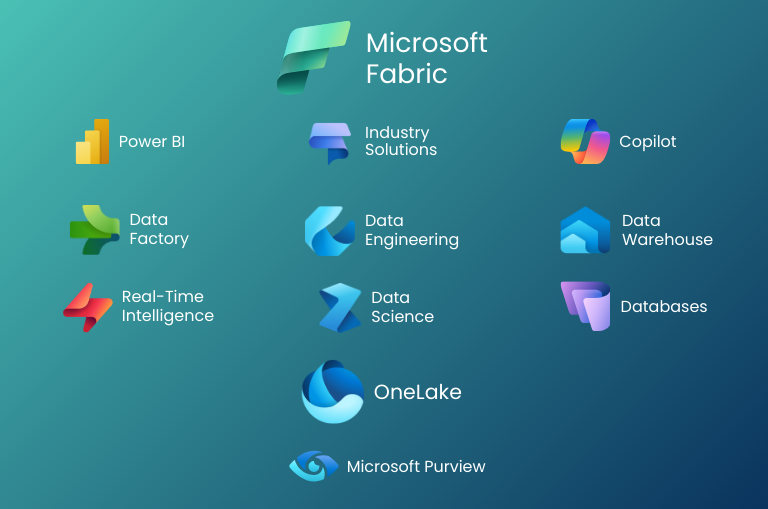Snowflake vs Microsoft Fabric: Data Platform Comparison
The revolution of artificial intelligence in business is gaining momentum, and its fuel is data. Modern data platforms, led by Snowflake and Microsoft Fabric, form the backbone of this transformation, enabling companies to collect, organise, and analyse invaluable information effectively.
However, the real change is not limited to implementing new technologies. AI transformation is primarily an evolution in thinking and decision-making, where data serves as a compass, and people — including interpreters and artificial intelligence — become discoverers of hidden patterns and optimisers of key processes.
What are modern data platforms?
A modern data platform is a comprehensive solution that enables the management of the entire data lifecycle — from acquisition, through storage, processing, to analysis and visualisation.
Unlike traditional systems, contemporary platforms offer scalability, flexibility, and advanced analytical functions, often using the cloud as the operating environment, which eliminates the need to manage physical infrastructure.
What is Snowflake
Snowflake is an innovative cloud-based data processing platform. It stands out with an architecture that separates data storage from computing power, ensuring the independent scaling of both elements.
Snowflake allows efficient management of both structured and unstructured data, offering advanced security features and high performance in analytical processing.
Snowflake employs a unique three-layer architecture, comprising cloud services (management), query processing (computing), and database storage. Thanks to the physical separation but logical integration of these elements, Snowflake delivers resources exactly when needed.
Benefits include flexible scaling, high performance due to columnar data structure, and independent management of computing power and disk space.
Strengths
Snowflake stands out for multi-cloud flexibility, operating on AWS, Azure, and Google Cloud. Its architecture, separating storage from computing, ensures unmatched scalability and performance. The platform offers advanced security features, supports a wide range of data types, and automatically manages infrastructure. Snowflake excels in data sharing between organisations, enabling secure collaboration. Moreover, the intuitive SQL interface and the ability to process complex queries quickly make it a powerful analytical tool.
Weaknesses
Despite its advantages, Snowflake has several limitations. Costs can quickly rise with intensive use and inefficient queries. The platform requires integration with external tools for data transformation and visualisation, which complicates the architecture. Snowflake offers fewer advanced native AI/ML functions compared to competitors. Migration of large datasets to Snowflake can be time-consuming and complex. Additionally, full utilisation of the platform requires good knowledge of SQL and specific Snowflake functions.
Integrations
Snowflake offers broad integration possibilities with various external tools. It supports popular ETL solutions (Informatica, Talend, Fivetran), visualisation tools (Tableau, Power BI, Looker), ML/AI platforms (DataRobot, SageMaker), and significant data ecosystems (Spark, Hadoop). Thanks to open APIs and connectors, Snowflake seamlessly integrates with existing IT infrastructures, enabling smooth data exchange between systems without the need for complex custom solutions.
AI and Machine Learning
Snowflake supports machine learning through Snowpark, enabling the execution of models such as XGBoost and Random Forest directly within the Snowflake environment. The platform integrates with external AI tools, such as DataRobot or SageMaker, enabling data processing without requiring data movement. Snowflake also supports LLM models through Cortex functions. It is an ideal solution for teams that focus on data storage and utilise external platforms for advanced AI analysis.
Pricing model
Snowflake offers a flexible pay-as-you-go pricing model based on actual resource consumption. Customers pay for used computing power (measured in credits) and data storage. This model allows scaling up or down without long-term commitments. Snowflake also employs a tiered approach, offering various editions (Standard, Enterprise, and Business Critical) that include additional features at higher prices.
When to choose Snowflake?
Choose Snowflake if your organisation needs a flexible, multi-cloud analytical solution with independent scaling of storage and computing. This platform is ideal when the priority is high query performance, seamless data sharing between organisations, and a flexible pay-as-you-go pricing model.
Snowflake is also suitable if you need an advanced data warehouse integrating with existing analytical and ETL tools, and your team has SQL experience and prefers specialised tools with a minimal learning curve.
What is Microsoft Fabric
Microsoft Fabric is a comprehensive analytics and data platform that combines various tools into a single environment. Based on SaaS architecture, it integrates components such as Data Factory, Data Engineering, Data Warehouse, and Power BI.
Its central element is OneLake — a unified data repository. Fabric offers built-in AI features, including Microsoft Copilot, which enables task automation and generates intelligent analyses.

Microsoft Fabric is based on SaaS architecture with OneLake as a central element that eliminates data silos. The platform unites all data workloads, from data engineering to data warehouses and real-time analytics.
Benefits include centralised data management, seamless integration with the Microsoft ecosystem, built-in AI functions, and a tiered architecture (bronze, silver, gold) supporting data processing from raw to advanced analytics.
See the company guide on Microsoft Fabric
Strengths
Microsoft Fabric stands out for its comprehensive integration of all aspects of data analytics into a single platform. A key advantage is OneLake — a unified repository eliminating data silos. Fabric offers a wide range of analytical tools tailored to various roles within an organisation. Native integration with the Microsoft ecosystem (Power BI, Azure, Microsoft 365) ensures a smooth workflow. Built-in AI functions, including Microsoft Copilot, automate tasks and provide intelligent analyses. Fabric also enables comprehensive data management with access control and regulatory compliance.
Weaknesses and limitations
Despite its complexity, Microsoft Fabric has some limitations. The platform is tightly integrated with the Microsoft ecosystem, which can complicate integration with solutions from other vendors. Fabric is relatively new, so it has less mature functionalities compared to specialised tools. Multi-cloud flexibility is mainly limited to Azure. The capacity model may be less flexible for organisations with variable computing needs. Additionally, the platform’s complexity can lengthen the learning curve for new users.
Integrations
Microsoft Fabric offers native integration with the entire Microsoft ecosystem, including Microsoft 365, Microsoft Azure, Microsoft Copilot Studio, and Microsoft Power Platform. It also features numerous connectors to external systems, including Snowflake, Google BigQuery, MongoDB, and AWS S3. Thanks to Data Factory, Fabric can pull data from various structured and unstructured sources. Integration with Power BI provides advanced visualisation capabilities, and connection with Microsoft Azure AI Foundry enables the use of advanced AI functions.
AI and Machine Learning
Microsoft Fabric offers advanced AI capabilities through integration with Azure Machine Learning in Microsoft Azure AI Foundry and Microsoft 365 Copilot. The platform enables the creation, deployment, and management of ML models within a unified environment, eliminating the need to switch between tools. AI features are embedded throughout the data lifecycle, from engineering to business analysis and beyond. Fabric automates routine tasks, generates quick reports, and builds auto-models, making it a good choice for companies seeking integrated AI experiences.
Pricing model
Microsoft Fabric offers two primary pricing models: Pay-as-you-go (flexible, with no commitments) and Reserved (up to 40% savings with an annual reservation). Costs depend on two main factors: computing power (Compute) and storage. Single computing power can handle all functions simultaneously and be shared across many projects. Fabric also offers three user license types: Free, Pro, and Premium, each available per user.
See the licensing and pricing guide for Microsoft Fabric
When to choose the Microsoft Fabric data platform?
Choose Microsoft Fabric if your organisation already uses the Microsoft ecosystem and needs a comprehensive platform that integrates all aspects of working with data. It is the ideal solution when you want a unified environment that combines data engineering, data warehouses, real-time analytics, and visualisation without switching between tools.
Fabric is suitable when advanced AI integration, data centralisation in OneLake, and simplified management with a single licensing model are priorities. It is also a good choice for organisations wanting to accelerate digital transformation without expanding specialised IT teams.
What is the difference between Snowflake and Microsoft Fabric
The primary difference between the platforms lies in their strategic approach and level of integration. Snowflake focuses on delivering a high-performance cloud data warehouse with flexible scaling and architecture, separating storage from computing. Microsoft Fabric offers a comprehensive, integrated analytics environment closely tied to the Microsoft ecosystem.
Snowflake stands out with its multi-cloud flexibility (supporting AWS, Microsoft Azure, and Google Cloud), while Fabric is firmly integrated with Microsoft services. Snowflake offers a credit-based pay-for-usage model, whereas Fabric uses a capacity-based pricing model with pay-as-you-go or reserved options. Fabric is more versatile, integrating various analytical tools in one platform, while Snowflake focuses on refining data warehousing and data sharing features.
The choice between them depends on existing infrastructure, specific analytical needs, and organisational integration preferences.
Which system to choose for a company?
Small company
For a small company, key selection factors are ease of implementation and minimising administrative costs.
If you already use Microsoft tools (Office 365, Teams), Microsoft Fabric will be a natural choice, offering a low entry barrier and intuitive analytical tools that don't require an IT team.
Snowflake will work well in tech startups needing a highly scalable solution with a flexible pay-as-you-go pricing model, especially when handling custom data or intensive analytics.
Medium company
A medium-sized company should base its choice on its existing IT infrastructure and specific analytical needs.
Microsoft Fabric will be optimal for organisations using the Microsoft ecosystem, needing integrated tools from data engineering to visualisation without significantly increasing the IT team.
Snowflake is ideal for companies that require high analytical performance, flexible scalability, and integration with diverse tools, particularly when using multiple cloud vendors or having an SQL-experienced team that prefers specialised analytical tools.
Large company
Large enterprises should choose based on IT strategy, existing investments, and long-term data management vision.
Snowflake is ideal for organisations that prefer a multi-cloud strategy, require exceptional flexibility in scaling analytical workloads, or need advanced data sharing functions between business units and external partners without compromising performance.
Microsoft Fabric will be preferred for corporations with an extensive Microsoft ecosystem that seeks a unified platform to handle all analytics and AI aspects under one roof.
Summary
The choice between Snowflake and Microsoft Fabric should be based on specific business needs, existing IT infrastructure, and the organisation’s long-term data strategy.
Snowflake stands out as a specialised, high-performance cloud data warehouse with flexible multi-cloud architecture and pay-as-you-go pricing. It is ideal for companies seeking a solution that focuses on advanced analytics and offers integration possibilities with diverse external tools.
Implementing Microsoft Fabric in a company brings numerous benefits. It offers a comprehensive, integrated analytics environment that covers the entire data lifecycle, with OneLake serving as a central repository and providing deep integration with the Microsoft ecosystem. It works well for organisations wanting to centralise data management, leverage advanced AI features, and reduce analytical infrastructure complexity.
Both platforms offer advanced security features, scalability, and support for modern AI use cases, but the final choice should reflect the company’s specific digital transformation goals. It is also worth considering integrating both solutions for maximum benefits in complex IT environments.

